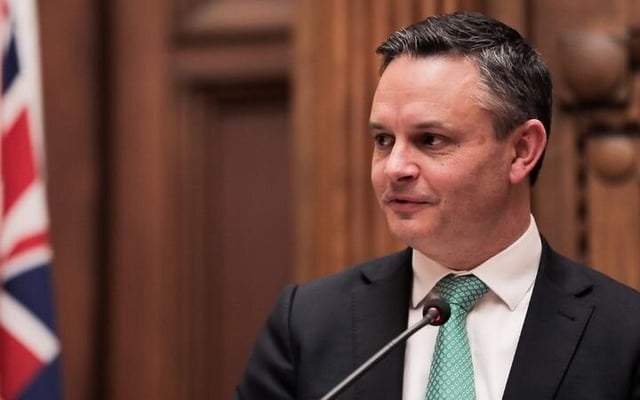Climate Change: Govt reveals first emission reduction plan

Low-income families who scrap their old car will get funding to buy a low-emitting vehicle in a $569 million scheme as one of the big-ticket items in the government's first Emissions Reductions Plan.
The plan sets out $2.9b of spending from the $4.5b Climate Emergency Response Fund (CERF) over the next four years, which is funded through the Emissions Trading Scheme.
It compares to $2.3b on climate change related spending in last year's Budget.
While today's announcement did not include widely expected public transport ticket subsidies, other new schemes include kerbside food scrap collection, national public transport ticketing, a low-emission vehicle leasing scheme for lower-income families, shoring up energy networks, and a big increase in spending on developing agricultural technology.
Initial $2.9b over four years from ETS, and $800m left over from what has been generated in the current forecast period means an additional $1.5b is able to be allocated to future budgets.
Further CERF initiatives are to be announced on Budget Day.
By the numbers
Transport: $1.3b from CERF
- $569m 'Scrap and replace' scheme for Clean Car programme with 2500 vehicles covered in intial trial
- $20m leasing scheme for low-emission vehicles for low-income families, starting in three communities from early next year
- $350m for improving access to low-impact transport like walking, cycling and public transport
- $23m to develop transport programmes for developing strategies for increasing use of active and shared transport
- $40m for decarbonising public transport buses by 2035
- $20m for decarbonising freight transport
- $61m to support bus driver workforce
- Further $100m to $217m intiatives to be announced on Budget Day
The improvements to access for low-emitting transport includes a rapid rollout for of at least 100km of urban cycleways; safety improvements in 25 pedestrian areas; improving school transport for 75-100 schools; bus priority upgrades for 40 locations;
Agriculture: $710m over four years from CERF
- $339m to accelerate technology , including establishing a Centre for Climate Action on Agricultural Emissions
- $256.2m to boost forestry to help with carbon sequestration
- $73.5m from Budget 2022 for forestry to increase use of woody biomass as an alternative to coal
- Over $6m to support implementation
- $35.4m to support a just transition for farmers, growers and whenua Maori
- The Sustainable Food and Fibre Future Fund for industry-led innovation with more than 170 farmer-led catchment groups
Energy: total seven-year spend of $1b
- $650m for the GIDI fund for decarbonising industry over four years, plus $25m already allocated in previous Budgets and planning for about $330m in future years
- $18m for developing energy strategies and frameworks
- $5m for electricity market and renewables work
- About $40m for heating efficiency in commercial spaces and water
- About $330m for energy efficiency improvements for businesses
Photo: RNZ / Angus Dreaver
Transport
As part of its goal of having electric vehicles make up at least 30 percent of the light fleet by 2035, the government will spend $569m from the Climate Emergency Response Fund on a new scheme to help increase the uptake of cleaner cars.
The scrap-to-replace scheme will give targeted financial assistance to lower and middle income families to purchase a low-emissions vehicle when they scrap their old car.
It will be trialled with up to 2500 cars before being rolled out further.
Further details about how the scheme will operate, including how much financial support families could receive to purchase a new vehicle, have not been announced.
Transport Minister Michael Wood said switching to a low- or zero-emission vehicle would help reduce costs for families in the long term.
He said this would help such families' finances in the long term too, with the cost of charging an electric vehicle at home during off peak hours equating to paying 40c per litre for petrol.
"Through supporting the uptake of cleaner vehicles, we are not only helping families do their bit for our planet, but also protecting them and our economy from future economic shocks and high fuel prices. This will also help safeguard New Zealand by reducing our international dependency on fossil fuels," Wood said.
From early next year, the government will also spend $20m on leasing low-emissions vehicles to low-income families through community organisations in three locations as a trial that could be rolled out wider in future.
A further $350m will be spent on speeding up the roll-out of cycle-ways, safety improvements around pedestrian areas, supporting safer travel to up to 100 schools and improving shelter, access and information at 500 bus stops and train stations.
The government has also committed to introducing a nationally integrated ticketing system for public transport, but has not indicated when this will happen.
Legislative changes to enable congestion charging may also be made, with ministers signalling that would take two years to develop.
Once a decision was made, ministers would work with Auckland Council and Wellington's city and regional councils to design how such a charge would work in the region.
The government will also monitor interest in the charge from other councils.
Some $60m will be spent on supporting the struggling bus driver workforce and $40m over four years on low-emitting buses.
The widely tipped extension of the three month half-price public transport fare subsidy wasn't included in today's plan. Transport currently accounts for 17 per cent of New Zealand's total greenhouse gas emissions.
Agriculture
The agriculture sector accounts for about half of New Zealand's emissions but as yet is not paying into the Emissions Trading Scheme which funds the CERF, yet the government has committed $710 million over four years to improvements in the industry.
This includes a large $339m spend on improving technology development, part of which would go towards establishing the Centre for Climate Action on Agricultural Emissions.
The Centre would work on developing and commercialising new products for reducing agricultural emissions.
Other spending would see work on He Waka Eke Noa - a plan worked on in partnership between the government and the industry on how to price agricultural emissions - progressed faster
Initiatives also include further work on 'green fuels', and a scheme to reduced waste going to landfill.
Energy
Part of the strategy with the energy sector is a ban on low- and medium-temperature coal boilers and phasing out existing ones by 2037, while hugely scaling up industry decarbonisation and investment in the electricity network.
It will significantly expand the government Investment in Decarbonising Industry Fund (GIDI) to help major energy users cut costs and emissions.
The initiatives in the initial round of funding (and to be finishing in 2024) are estimated to save 7.46 million tonnes of CO2 over their lifetime.
The expanded energy programme aims to cut 17 percent of total emissions required in the next three years, and about a third of emissions reductions required by the end of the decade.
There are also plans to protect New Zealanders from global energy price spikes in the long term.
A scheme for helping businesses buy energy efficient equipment such as heaps pumps, space and water heating in industrial and commercial processes.
Woods says we must wean ourselves off expensive fossil fuels.
It puts $18m towards energy strategies, including a hydrogen roadmap and regulatory framework for offshore wind farms.
More to come...
Low-income families who scrap their old car will get funding to buy a low-emitting vehicle in a $569 million scheme as one of the big-ticket items in the government's first Emissions Reductions Plan.
The plan sets out $2.9b of spending from the $4.5b Climate Emergency Response Fund (CERF) over the...
Low-income families who scrap their old car will get funding to buy a low-emitting vehicle in a $569 million scheme as one of the big-ticket items in the government's first Emissions Reductions Plan.
The plan sets out $2.9b of spending from the $4.5b Climate Emergency Response Fund (CERF) over the next four years, which is funded through the Emissions Trading Scheme.
It compares to $2.3b on climate change related spending in last year's Budget.
While today's announcement did not include widely expected public transport ticket subsidies, other new schemes include kerbside food scrap collection, national public transport ticketing, a low-emission vehicle leasing scheme for lower-income families, shoring up energy networks, and a big increase in spending on developing agricultural technology.
Initial $2.9b over four years from ETS, and $800m left over from what has been generated in the current forecast period means an additional $1.5b is able to be allocated to future budgets.
Further CERF initiatives are to be announced on Budget Day.
By the numbers
Transport: $1.3b from CERF
- $569m 'Scrap and replace' scheme for Clean Car programme with 2500 vehicles covered in intial trial
- $20m leasing scheme for low-emission vehicles for low-income families, starting in three communities from early next year
- $350m for improving access to low-impact transport like walking, cycling and public transport
- $23m to develop transport programmes for developing strategies for increasing use of active and shared transport
- $40m for decarbonising public transport buses by 2035
- $20m for decarbonising freight transport
- $61m to support bus driver workforce
- Further $100m to $217m intiatives to be announced on Budget Day
The improvements to access for low-emitting transport includes a rapid rollout for of at least 100km of urban cycleways; safety improvements in 25 pedestrian areas; improving school transport for 75-100 schools; bus priority upgrades for 40 locations;
Agriculture: $710m over four years from CERF
- $339m to accelerate technology , including establishing a Centre for Climate Action on Agricultural Emissions
- $256.2m to boost forestry to help with carbon sequestration
- $73.5m from Budget 2022 for forestry to increase use of woody biomass as an alternative to coal
- Over $6m to support implementation
- $35.4m to support a just transition for farmers, growers and whenua Maori
- The Sustainable Food and Fibre Future Fund for industry-led innovation with more than 170 farmer-led catchment groups
Energy: total seven-year spend of $1b
- $650m for the GIDI fund for decarbonising industry over four years, plus $25m already allocated in previous Budgets and planning for about $330m in future years
- $18m for developing energy strategies and frameworks
- $5m for electricity market and renewables work
- About $40m for heating efficiency in commercial spaces and water
- About $330m for energy efficiency improvements for businesses
Photo: RNZ / Angus Dreaver
Transport
As part of its goal of having electric vehicles make up at least 30 percent of the light fleet by 2035, the government will spend $569m from the Climate Emergency Response Fund on a new scheme to help increase the uptake of cleaner cars.
The scrap-to-replace scheme will give targeted financial assistance to lower and middle income families to purchase a low-emissions vehicle when they scrap their old car.
It will be trialled with up to 2500 cars before being rolled out further.
Further details about how the scheme will operate, including how much financial support families could receive to purchase a new vehicle, have not been announced.
Transport Minister Michael Wood said switching to a low- or zero-emission vehicle would help reduce costs for families in the long term.
He said this would help such families' finances in the long term too, with the cost of charging an electric vehicle at home during off peak hours equating to paying 40c per litre for petrol.
"Through supporting the uptake of cleaner vehicles, we are not only helping families do their bit for our planet, but also protecting them and our economy from future economic shocks and high fuel prices. This will also help safeguard New Zealand by reducing our international dependency on fossil fuels," Wood said.
From early next year, the government will also spend $20m on leasing low-emissions vehicles to low-income families through community organisations in three locations as a trial that could be rolled out wider in future.
A further $350m will be spent on speeding up the roll-out of cycle-ways, safety improvements around pedestrian areas, supporting safer travel to up to 100 schools and improving shelter, access and information at 500 bus stops and train stations.
The government has also committed to introducing a nationally integrated ticketing system for public transport, but has not indicated when this will happen.
Legislative changes to enable congestion charging may also be made, with ministers signalling that would take two years to develop.
Once a decision was made, ministers would work with Auckland Council and Wellington's city and regional councils to design how such a charge would work in the region.
The government will also monitor interest in the charge from other councils.
Some $60m will be spent on supporting the struggling bus driver workforce and $40m over four years on low-emitting buses.
The widely tipped extension of the three month half-price public transport fare subsidy wasn't included in today's plan. Transport currently accounts for 17 per cent of New Zealand's total greenhouse gas emissions.
Agriculture
The agriculture sector accounts for about half of New Zealand's emissions but as yet is not paying into the Emissions Trading Scheme which funds the CERF, yet the government has committed $710 million over four years to improvements in the industry.
This includes a large $339m spend on improving technology development, part of which would go towards establishing the Centre for Climate Action on Agricultural Emissions.
The Centre would work on developing and commercialising new products for reducing agricultural emissions.
Other spending would see work on He Waka Eke Noa - a plan worked on in partnership between the government and the industry on how to price agricultural emissions - progressed faster
Initiatives also include further work on 'green fuels', and a scheme to reduced waste going to landfill.
Energy
Part of the strategy with the energy sector is a ban on low- and medium-temperature coal boilers and phasing out existing ones by 2037, while hugely scaling up industry decarbonisation and investment in the electricity network.
It will significantly expand the government Investment in Decarbonising Industry Fund (GIDI) to help major energy users cut costs and emissions.
The initiatives in the initial round of funding (and to be finishing in 2024) are estimated to save 7.46 million tonnes of CO2 over their lifetime.
The expanded energy programme aims to cut 17 percent of total emissions required in the next three years, and about a third of emissions reductions required by the end of the decade.
There are also plans to protect New Zealanders from global energy price spikes in the long term.
A scheme for helping businesses buy energy efficient equipment such as heaps pumps, space and water heating in industrial and commercial processes.
Woods says we must wean ourselves off expensive fossil fuels.
It puts $18m towards energy strategies, including a hydrogen roadmap and regulatory framework for offshore wind farms.
More to come...










Leave a Comment